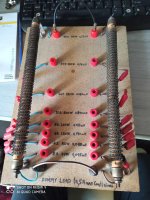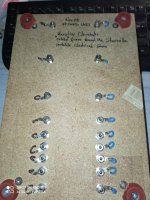Anybody else do this?
I bought an old hotplate at a yard sale which is essentially some nichrome wire wrapped at about one turn per 1/8" over a 3/16" mandrel. The coil is weaved into the the channels of the ceramic base. I measured the resistance cold - 16ohms. I ran a variac into it to see how much the coil impedance changed over the 75W output of my variac. It increased about 1ohm. It gets hot with 2.5 amps running into into it. Doesn't turn red.
Anyway I think it's a great noiseless 16ohm load to test a power amp at full output swing with.
I bought an old hotplate at a yard sale which is essentially some nichrome wire wrapped at about one turn per 1/8" over a 3/16" mandrel. The coil is weaved into the the channels of the ceramic base. I measured the resistance cold - 16ohms. I ran a variac into it to see how much the coil impedance changed over the 75W output of my variac. It increased about 1ohm. It gets hot with 2.5 amps running into into it. Doesn't turn red.
Anyway I think it's a great noiseless 16ohm load to test a power amp at full output swing with.
I tested a mains cold start circuit with an oil filled electric heater.
It can switch between 1, 2 and 3 kilowatts so was a good test.
It can switch between 1, 2 and 3 kilowatts so was a good test.
The max resistance of a heating element is at it’s max operating temperature. This Rmax can be deduced from the formula R=(V^2)/W
R in Ohm, V in Vrms, W in Watt from dataplate
The max temp of an open coil heating element is 350-370 d Celsius.
Open coil temperature vs applied watts isn’t a linear relationship (due to neither heat convection nor heat radiation losses are linear)
George
R in Ohm, V in Vrms, W in Watt from dataplate
The max temp of an open coil heating element is 350-370 d Celsius.
Open coil temperature vs applied watts isn’t a linear relationship (due to neither heat convection nor heat radiation losses are linear)
George
Attachments
- Home
- Design & Build
- Equipment & Tools
- Hot plate as speaker load

